[English] 日本語
 Yorodumi
Yorodumi- PDB-6ac5: Crystal structure of RIPK1 death domain GlcNAcylated by EPEC effe... -
+ Open data
Open data
- Basic information
Basic information
| Entry | Database: PDB / ID: 6ac5 | ||||||
|---|---|---|---|---|---|---|---|
| Title | Crystal structure of RIPK1 death domain GlcNAcylated by EPEC effector NleB | ||||||
 Components Components | Receptor-interacting serine/threonine-protein kinase 1 | ||||||
 Keywords Keywords | SIGNALING PROTEIN / apoptosis | ||||||
| Function / homology |  Function and homology information Function and homology informationripoptosome assembly / positive regulation of miRNA processing / positive regulation of interleukin-6-mediated signaling pathway / ripoptosome assembly involved in necroptotic process / death domain binding / peptidyl-serine autophosphorylation / ripoptosome / Defective RIPK1-mediated regulated necrosis / Microbial modulation of RIPK1-mediated regulated necrosis / TRIF-mediated programmed cell death ...ripoptosome assembly / positive regulation of miRNA processing / positive regulation of interleukin-6-mediated signaling pathway / ripoptosome assembly involved in necroptotic process / death domain binding / peptidyl-serine autophosphorylation / ripoptosome / Defective RIPK1-mediated regulated necrosis / Microbial modulation of RIPK1-mediated regulated necrosis / TRIF-mediated programmed cell death / Regulation by c-FLIP / CASP8 activity is inhibited / Dimerization of procaspase-8 / TLR3-mediated TICAM1-dependent programmed cell death / TNF signaling / programmed necrotic cell death / Caspase activation via Death Receptors in the presence of ligand / SARS-CoV-1-mediated effects on programmed cell death / positive regulation of macrophage differentiation / JUN kinase kinase kinase activity / T cell apoptotic process / necroptotic signaling pathway / NF-kB activation through FADD/RIP-1 pathway mediated by caspase-8 and -10 / death-inducing signaling complex / RIP-mediated NFkB activation via ZBP1 / positive regulation of necroptotic process / negative regulation of necroptotic process / positive regulation of tumor necrosis factor-mediated signaling pathway / death receptor binding / positive regulation of programmed cell death / positive regulation of programmed necrotic cell death / positive regulation of extrinsic apoptotic signaling pathway / TNFR1-induced proapoptotic signaling / RIPK1-mediated regulated necrosis / TRP channels / necroptotic process / response to tumor necrosis factor / positive regulation of execution phase of apoptosis / canonical NF-kappaB signal transduction / negative regulation of extrinsic apoptotic signaling pathway in absence of ligand / extrinsic apoptotic signaling pathway / signaling adaptor activity / negative regulation of canonical NF-kappaB signal transduction / TICAM1, RIP1-mediated IKK complex recruitment / IKK complex recruitment mediated by RIP1 / tumor necrosis factor-mediated signaling pathway / TNFR1-induced NF-kappa-B signaling pathway / negative regulation of extrinsic apoptotic signaling pathway / positive regulation of interleukin-8 production / positive regulation of JNK cascade / Regulation of TNFR1 signaling / protein catabolic process / positive regulation of non-canonical NF-kappaB signal transduction / : / Regulation of necroptotic cell death / cellular response to growth factor stimulus / cellular response to hydrogen peroxide / positive regulation of reactive oxygen species metabolic process / positive regulation of protein phosphorylation / positive regulation of inflammatory response / positive regulation of tumor necrosis factor production / cellular response to tumor necrosis factor / Ovarian tumor domain proteases / positive regulation of neuron apoptotic process / protein autophosphorylation / response to oxidative stress / amyloid fibril formation / Potential therapeutics for SARS / non-specific serine/threonine protein kinase / protein kinase activity / positive regulation of canonical NF-kappaB signal transduction / receptor complex / endosome membrane / Ub-specific processing proteases / intracellular signal transduction / positive regulation of apoptotic process / inflammatory response / protein serine kinase activity / protein serine/threonine kinase activity / apoptotic process / ubiquitin protein ligase binding / positive regulation of gene expression / negative regulation of apoptotic process / protein-containing complex binding / protein homodimerization activity / positive regulation of transcription by RNA polymerase II / protein-containing complex / mitochondrion / ATP binding / identical protein binding / plasma membrane / cytosol / cytoplasm Similarity search - Function | ||||||
| Biological species |  Homo sapiens (human) Homo sapiens (human) | ||||||
| Method |  X-RAY DIFFRACTION / X-RAY DIFFRACTION /  SYNCHROTRON / SYNCHROTRON /  MOLECULAR REPLACEMENT / Resolution: 1.451 Å MOLECULAR REPLACEMENT / Resolution: 1.451 Å | ||||||
 Authors Authors | Ding, J. / Shao, F. | ||||||
 Citation Citation |  Journal: Mol.Cell / Year: 2019 Journal: Mol.Cell / Year: 2019Title: Structural and Functional Insights into Host Death Domains Inactivation by the Bacterial Arginine GlcNAcyltransferase Effector. Authors: Ding, J. / Pan, X. / Du, L. / Yao, Q. / Xue, J. / Yao, H. / Wang, D.C. / Li, S. / Shao, F. | ||||||
| History |
|
- Structure visualization
Structure visualization
| Structure viewer | Molecule:  Molmil Molmil Jmol/JSmol Jmol/JSmol |
|---|
- Downloads & links
Downloads & links
- Download
Download
| PDBx/mmCIF format |  6ac5.cif.gz 6ac5.cif.gz | 58.1 KB | Display |  PDBx/mmCIF format PDBx/mmCIF format |
|---|---|---|---|---|
| PDB format |  pdb6ac5.ent.gz pdb6ac5.ent.gz | 40.7 KB | Display |  PDB format PDB format |
| PDBx/mmJSON format |  6ac5.json.gz 6ac5.json.gz | Tree view |  PDBx/mmJSON format PDBx/mmJSON format | |
| Others |  Other downloads Other downloads |
-Validation report
| Summary document |  6ac5_validation.pdf.gz 6ac5_validation.pdf.gz | 451.7 KB | Display |  wwPDB validaton report wwPDB validaton report |
|---|---|---|---|---|
| Full document |  6ac5_full_validation.pdf.gz 6ac5_full_validation.pdf.gz | 451.6 KB | Display | |
| Data in XML |  6ac5_validation.xml.gz 6ac5_validation.xml.gz | 7.4 KB | Display | |
| Data in CIF |  6ac5_validation.cif.gz 6ac5_validation.cif.gz | 9.7 KB | Display | |
| Arichive directory |  https://data.pdbj.org/pub/pdb/validation_reports/ac/6ac5 https://data.pdbj.org/pub/pdb/validation_reports/ac/6ac5 ftp://data.pdbj.org/pub/pdb/validation_reports/ac/6ac5 ftp://data.pdbj.org/pub/pdb/validation_reports/ac/6ac5 | HTTPS FTP |
-Related structure data
| Related structure data | 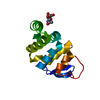 6ac0C  6aciSC 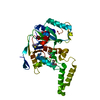 6e66C C: citing same article ( S: Starting model for refinement |
|---|---|
| Similar structure data |
- Links
Links
- Assembly
Assembly
| Deposited unit | 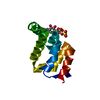
| ||||||||
|---|---|---|---|---|---|---|---|---|---|
| 1 |
| ||||||||
| Unit cell |
|
- Components
Components
| #1: Protein | Mass: 12843.546 Da / Num. of mol.: 1 / Fragment: Death domain Source method: isolated from a genetically manipulated source Source: (gene. exp.)  Homo sapiens (human) / Gene: RIPK1, RIP, RIP1 / Plasmid: pGEX6p / Production host: Homo sapiens (human) / Gene: RIPK1, RIP, RIP1 / Plasmid: pGEX6p / Production host:  References: UniProt: Q13546, non-specific serine/threonine protein kinase | ||||
|---|---|---|---|---|---|
| #2: Sugar | ChemComp-NAG / | ||||
| #3: Chemical | | #4: Water | ChemComp-HOH / | Has protein modification | Y | |
-Experimental details
-Experiment
| Experiment | Method:  X-RAY DIFFRACTION / Number of used crystals: 1 X-RAY DIFFRACTION / Number of used crystals: 1 |
|---|
- Sample preparation
Sample preparation
| Crystal | Density Matthews: 1.79 Å3/Da / Density % sol: 31.26 % |
|---|---|
| Crystal grow | Temperature: 293 K / Method: vapor diffusion, sitting drop / pH: 5.5 / Details: 2.2 M ammonium sulfate, 100 mM Bis-Tris pH 5.5 |
-Data collection
| Diffraction | Mean temperature: 93 K |
|---|---|
| Diffraction source | Source:  SYNCHROTRON / Site: SYNCHROTRON / Site:  SSRF SSRF  / Beamline: BL17U / Wavelength: 0.97928 Å / Beamline: BL17U / Wavelength: 0.97928 Å |
| Detector | Type: ADSC QUANTUM 315r / Detector: CCD / Date: May 30, 2014 |
| Radiation | Protocol: SINGLE WAVELENGTH / Monochromatic (M) / Laue (L): M / Scattering type: x-ray |
| Radiation wavelength | Wavelength: 0.97928 Å / Relative weight: 1 |
| Reflection | Resolution: 1.45→32.8 Å / Num. obs: 17069 / % possible obs: 99.9 % / Redundancy: 13.2 % / Rmerge(I) obs: 0.077 / Net I/σ(I): 21.4 |
| Reflection shell | Resolution: 1.45→1.53 Å / Redundancy: 11.4 % / Rmerge(I) obs: 0.265 / Mean I/σ(I) obs: 7.9 / Num. unique obs: 2421 / % possible all: 100 |
- Processing
Processing
| Software |
| |||||||||||||||||||||||||||||||||||||||||||||||||
|---|---|---|---|---|---|---|---|---|---|---|---|---|---|---|---|---|---|---|---|---|---|---|---|---|---|---|---|---|---|---|---|---|---|---|---|---|---|---|---|---|---|---|---|---|---|---|---|---|---|---|
| Refinement | Method to determine structure:  MOLECULAR REPLACEMENT MOLECULAR REPLACEMENTStarting model: 6ACI Resolution: 1.451→26.126 Å / SU ML: 0.11 / Cross valid method: FREE R-VALUE / σ(F): 1.36 / Phase error: 17.15
| |||||||||||||||||||||||||||||||||||||||||||||||||
| Solvent computation | Shrinkage radii: 0.9 Å / VDW probe radii: 1.11 Å | |||||||||||||||||||||||||||||||||||||||||||||||||
| Refinement step | Cycle: LAST / Resolution: 1.451→26.126 Å
| |||||||||||||||||||||||||||||||||||||||||||||||||
| Refine LS restraints |
| |||||||||||||||||||||||||||||||||||||||||||||||||
| LS refinement shell |
|
 Movie
Movie Controller
Controller


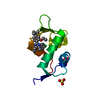
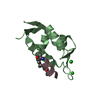


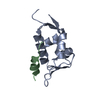
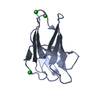
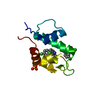



 PDBj
PDBj













